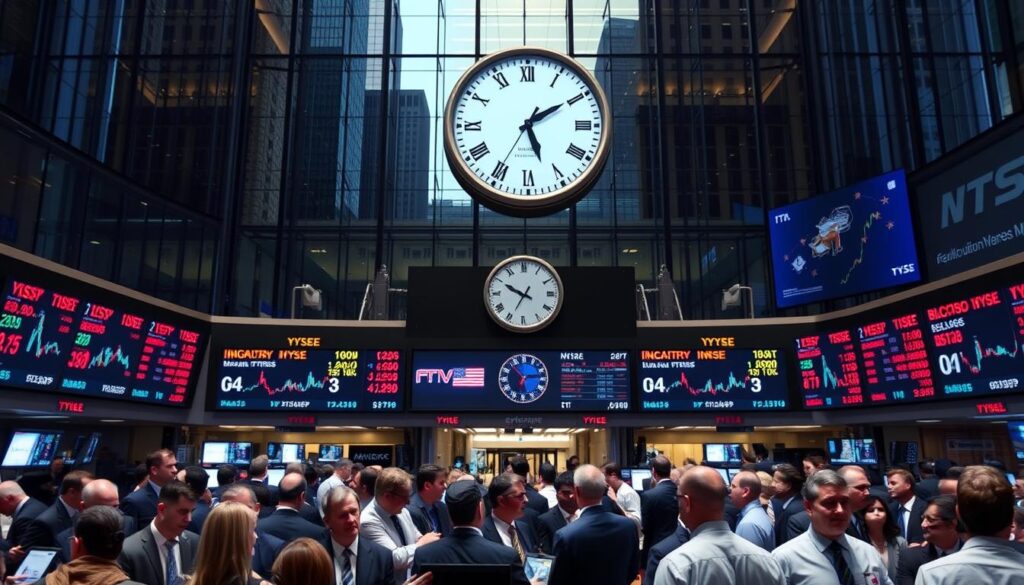Knowing if the stock market is open today is key for investors. The market has set hours, and knowing these stock market hours helps in planning your investments. In the U.S., the market is open from 9:30 a.m. to 4 p.m. ET, Monday to Friday. But, there are also extra trading times before and after these hours that can change the market.
Many things, like holidays and market conditions, can change the stock market’s status today. We will explore the different times the stock market is open. This includes regular and extra hours, and how they affect investors.
Key Takeaways
- The U.S. stock market is open from 9:30 a.m. to 4 p.m. ET on weekdays.
- Extended trading hours include pre-market and after-hours sessions.
- Holidays can close the stock market, impacting trading opportunities.
- Investors should check stock market hours regularly for optimal trading strategies.
- Understanding today’s stock market status helps in making informed investment decisions.
Understanding Stock Market Operating Hours
Investors need to know the stock market schedule to trade well. They must understand when the market is open or closed. For big exchanges like the New York Stock Exchange (NYSE) and NASDAQ, trading starts at 9:30 AM and ends at 4:00 PM Eastern Time, from Monday to Friday.
Regular Trading Hours Explained
During regular hours, buying and selling happen at clear prices. This affects the market a lot. Knowing when to trade helps investors make the most of their chances and avoid risks.
Events like the NYSE closing on July 4 for Independence Day show why it’s key to stay updated. Also, the early close at 1 PM on Christmas Eve is important to remember.
Extended Hours and Their Importance
Extended hours let investors trade outside regular times. This includes pre-market trading from 4 AM to 9:30 AM and after-hours trading from 4 PM to 8 PM. These times might not have as much activity as regular hours but can still affect prices and liquidity.
Knowing about these extended times can help investors plan better. It lets them act fast on market news, figuring out if the market is open or closed.
Key U.S. Stock Exchanges: NYSE and NASDAQ
The U.S. stock market has two main exchanges: the New York Stock Exchange (NYSE) and the NASDAQ. Each exchange has its own special features. These features appeal to different trading styles and investor needs. Knowing these differences helps understand the stock market better and can shape trading strategies.
Differences Between NYSE and NASDAQ
The NYSE is a traditional exchange with a physical trading floor. Brokers trade face-to-face here. It uses a mix of floor trading and electronic systems.
NASDAQ, on the other hand, is an electronic marketplace. It focuses on fast and efficient trades. These differences affect how investors trade, especially during certain stock market hours.
Trading Hours for Major Exchanges
The NYSE and NASDAQ usually trade from 9:30 a.m. to 4:00 p.m. ET on weekdays. They also offer extended hours from 4:00 p.m. to 8:00 p.m. ET. This extra time can be useful for traders.
However, the market can be more volatile during these extended hours. Knowing when the market is open or closed is crucial for making investment decisions.
Holidays and Their Impact on Trading
Knowing the stock market holiday schedule is key for investors. National holidays can change trading, closing markets or shortening hours. Knowing these dates helps investors plan better.
National Holidays Affecting the Stock Market
The U.S. stock market closes on federal holidays each year. In 2025, the New York Stock Exchange and Nasdaq will be closed on:
- New Year’s Day: January 1
- Martin Luther King Jr. Day: January 20
- Presidents’ Day: February 17
- Good Friday: April 18
- Memorial Day: May 26
- Juneteenth: June 19
- Independence Day: July 4
- Labor Day: September 1
- Thanksgiving Day: November 27
- Christmas Day: December 25
Also, the market closes early at 1:00 PM ET on the day before Independence Day, the day after Thanksgiving, and Christmas Eve. These early closures can mess up trading plans. Investors need to adjust their strategies to keep up with the market.
Recognizing Market Half-Days
Half-days in the stock market happen before big holidays. They lead to big changes in trading volume. Liquidity drops as traders rush to finish their deals before the holiday. Knowing the holiday schedule helps investors deal with these days and plan ahead.
Checking Real-Time Market Status
Investors must stay current with the stock market to make smart choices. Knowing the latest market trends helps spot trading chances. The right tools give access to real-time data, making it simpler to understand trading hours today.
Resources for Current Market Condition
Many financial sites offer live updates and in-depth market analysis. These are key for tracking real-time shifts. Sites like Yahoo Finance, CNBC, and Bloomberg are great resources. They include:
- Live stock price updates
- Market analysis and commentaries
- Historical data for informed decision-making
Mobile Apps for Stock Market Updates
Mobile apps are vital for investors. Apps from brokers like TD Ameritrade and E*TRADE send alerts about trading hours and market changes. Here are some app features:
| App | Key Features | Availability |
|---|---|---|
| TD Ameritrade | Stream real-time quotes, financial news, and alerts | iOS, Android |
| E*TRADE | Comprehensive trading tools, real-time data access | iOS, Android |
| Robinhood | User-friendly interface, market insights | iOS, Android |
How Market Openings Affect Investors
Knowing when the market opens is key for smart investing. The start of the market can change how investors act and affect stock prices. Today’s market hours show when chances to make money come up, leading to ups and downs in trading.
Smart investors know how market starts impact their plans. They adjust their strategies to fit these changes.
Importance of Knowing Market Status
Knowing if the market is open today helps in making trading plans. The early hours often set the tone for the day, showing trends and possible ups and downs. Big volumes at the start usually mean big players are involved.
This busy start often means trends will stick and can show big changes in the market.
But, if volumes are low, it might mean only short-term traders are active. This can lead to more stable prices during the day. It’s important to watch price changes and volumes closely. Big moves without enough volume might fail.
Looking at the tick index, on-balance volume, and Chaikin money flow helps understand the market’s first moves.
Strategies for Trading Based on Market Hours
Investors can improve their strategies by looking at pre-market moves and global market actions. Knowing how big news affects investor mood helps prepare for the market’s start. Good news can make prices jump up, while bad news can make them drop before trading starts.
Using these insights in trading plans can help make better buy and sell choices. Knowing the size of orders also matters. Big orders can show upcoming trends, while small ones might mean little change. A good strategy considers all these factors to better navigate the market.
| Factor | Impact on Trading |
|---|---|
| High Opening Volume | Indicates potential trends and volatility. |
| Low Opening Volume | Suggests a range-bound trading day, primarily short-term trades. |
| Major Announcements | Can lead to sharp price changes at market open based on sentiment. |
| Pre-Market Movements | Aids in predicting opening price adjustments and volatility. |
| Large Orders | Can signal emerging trends or limited price movement based on direction. |
Global Market Influence on U.S. Stocks
The global markets have a big impact on U.S. stock trading. News from overseas can hint at what’s to come in the U.S. markets. For example, when Japan’s Nikkei or Germany’s DAX fall, it often sets the tone for the U.S. market.
How International Markets Affect U.S. Trading
U.S. stock prices often depend on how international markets do. Here’s what’s happening:
- Germany’s DAX recently dropped 0.2%, closing at 20,285.80.
- The FTSE 100 surged 0.6% to 8,302.33, showing some sectors are doing well.
- Asian indices saw mixed results, with Japan’s Nikkei losing 0.9% and Hong Kong’s Hang Seng down 0.2%.
These changes lead to smart moves during U.S. trading hours. Traders keep a close eye on what’s happening abroad.
The Role of Global Events on Market Outlook
Global events are key in shaping the outlook for U.S. stocks. Important factors include:
- Political events, like elections and trade deals, create uncertainty that affects global markets.
- Economic reports, like China’s recent consumer price index rise of 0.1% year-over-year, influence decisions worldwide, including in the U.S.
- Market sentiment is influenced by U.S. index gains, like the S&P 500’s 0.2% rise, showing how investors react to global news.
Staying updated on international trading hours is crucial for traders. It helps them understand the global market’s impact on U.S. trading.
Economic Indicators and Market Reactions
Knowing about economic indicators is key for investors. It helps them make smart trading choices, especially when the market is up and down. Important numbers like job rates, inflation, and GDP growth guide how stocks move. Knowing when to trade based on these numbers is crucial.
Key Indicators Investors Should Monitor
Several economic indicators show how the market is doing:
- Core Personal Consumption Expenditure (PCE) Inflation: It’s about 2.8%, higher than the Federal Reserve wants.
- Private Sector Employment: December saw a 122,000 job gain, less than expected.
- Job Openings: November had 8.1 million openings, more than forecasted.
- Initial Jobless Claims: Went down to 201,000, showing a strong job market.
- ISM Services PMI: December’s score of 54.1 means growth, beating forecasts.
Understanding Market Volatility
Market ups and downs often come from new economic data. Lately, big companies have done better than small ones. This shows investors want safety in uncertain times.
Health care and materials sectors have seen big gains. This shows how different industries react to the economy.
The 10-year U.S. Treasury yield has hit a 2023 high. Investors need to watch interest rates and policy changes. If inflation drops, rates might go down, affecting the market.
Knowing these things during trading hours today is vital. It helps investors make smart choices in a shaky market.
| Indicator | Current Value | Benchmark/Expectation | Impact on Market |
|---|---|---|---|
| Core PCE Inflation | 2.8% | 2.0% | Negative |
| Private Sector Employment | 122,000 jobs | 140,000 jobs | Negative |
| Job Openings | 8.1 million | 7.7 million | Positive |
| Initial Jobless Claims | 201,000 | 215,000 | Positive |
| ISM Services PMI | 54.1 | 53 | Positive |
Tips for New Investors
Starting out in the stock market can feel overwhelming. But knowing the stock market hours can make a big difference. New investors should look into various resources to get started. It’s key to know if the market is open or closed to make smart choices.
Resources for Learning About Trading Hours
There are many educational resources to help new traders. Consider using:
- Online courses that teach market basics and trading strategies.
- Financial news websites for updates on market hours and conditions.
- Webinars by experts on market hours and trading tips.
How to Stay Updated as a Beginner
Staying informed about stock market hours is vital for managing your investments. Here are some tips:
- Subscribe to financial newsletters for daily updates on market status and trading hours.
- Join financial forums to connect with experienced traders for advice.
- Use trading apps that send notifications for market opening and closing times.
Knowing how market open or closed times impact trading is empowering. The right resources help new investors engage in the market. They also help in developing effective trading strategies.
The Future of Stock Market Trading
New technologies are changing the stock market fast. Things like algorithmic trading and artificial intelligence make trading more efficient. These changes might alter how and when we trade, affecting both personal and big investors.
Innovations in Market Operations
Technology is key in the stock market’s growth. Algorithmic trading automates orders, cutting down on manual work and speeding up deals. Artificial intelligence helps analyze big data fast, leading to smarter choices. This could mean longer trading hours to meet global demand.
Predictions for Market Trends
Experts think trading will soon blend global markets more. With connected platforms, trading could happen all day, every day. This might change trading hours to fit different time zones. More access to markets could also mean more ups and downs as traders react to news instantly.
Common Questions About Stock Market Hours
Knowing when the stock market is open or closed is key for investors. It affects your trading plans. Many people wonder about trading hours today and what to do when the market is closed.
Is the Stock Market Open on Weekends?
The stock market is closed on weekends. This means no trading on Saturdays and Sundays. It gives investors time to plan without rush. Even though some online sites allow trading, big exchanges like NYSE and NASDAQ are quiet.
What to Do if the Market is Closed?
When the market is closed, you can still be productive. Here are some ideas:
- Check your investment portfolio for improvements.
- Look into stocks you might want to buy later.
- Learn about trading strategies and market analysis.
Doing these things helps you get ready for when the market opens. Knowing the market’s status is vital for smart investing.
The Role of Technology in Stock Trading
Technology is key in today’s stock trading, shaping market hours and trading styles. Online platforms and tools give investors real-time data and new chances. This change helps both small and big investors do well.
The Impact of Trading Platforms on Hours
Online brokerages have changed trading, letting people work on stocks outside regular hours. It’s important to know how these changes affect when we trade. About 70% of U.S. stock market trades show how big algorithmic trading is.
Trading tech brings benefits like:
- Real-time data analysis
- Automated trade execution
- Access to global markets
- High-frequency trading (HFT) opportunities
These tools change how we trade and help us make better choices. With more algorithmic trading on the way, tech will keep playing a big role in trading.
Emerging Technologies and Market Access
New tech like blockchain and AI makes getting into the market easier. AI looks at huge amounts of data to make trading smarter. AI can:
- Trade faster than people
- Give instant market insights
- Help manage risks
- Spot fraud better
As AI gets better, it keeps an eye on trading, helping us stay aware of risks and market changes. The growing value of AI shows its big role in trading.
| Year | Global AI Market Value (USD) | CAGR |
|---|---|---|
| 2023 | 18.2 billion | 10.2% |
| 2033 | 50.4 billion | 10.2% |
In summary, new tech in trading opens doors for all investors, helping them make smart choices. As the market keeps changing, knowing these trends helps us navigate it better.
Conclusion: Staying Informed is Key
In today’s fast world, knowing when the stock market is open is crucial. Checking the stock market status regularly helps investors make quick decisions. It also improves their investment plans. By knowing if the market is open, people can grab trading chances and quickly respond to changes.
It’s important for investors to keep up with the market. This means understanding how different exchanges work. Whether it’s watching NYSE and NASDAQ or after-hours trading, being active helps. This knowledge helps investors deal with changes and spot new trends.
Being aware of market conditions and acting fast can really help your investments. With the right info, investors can feel more confident and make smart choices. Always staying informed helps you take advantage of the stock market’s changes.



